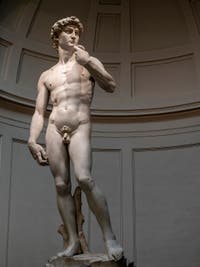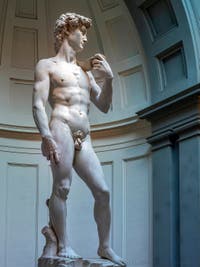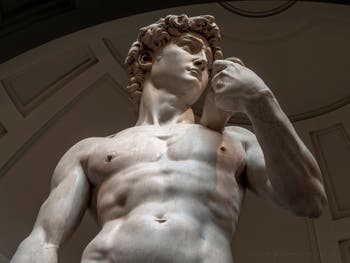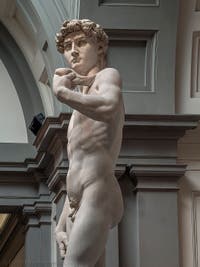Accademia Artists | Location | Opening Hours Tickets | Authorizations
Artists Sculptors | Painters | Music
Sculptors Michelangelo | Giambologna
Michelangelo David | Tomb Pope Julius II | Pietà - St. Matthew
David David Goliath | Masterpiece | Consecration Pictures Pages: 01 | 02 | 03 | 04
Michelangelo David in the Accademia Gallery in Florence in Italy

Michelangelo David Known and admired by the whole world, Michelangelo's David gained fame immediately after being unveiled to the Florentine public, surprised and amazed by the extraordinary beauty of this marble athlete of more than five metres in height.
An Original Work Breaking with the Previous “David”
Michelangelo had carved an absolutely original work, different from Donatello and Verrocchio, representing a frail teenager holding the sword with which he cut off his opponent's head resting at his feet.This monumental statue of a naked young man, armed with a simple stone and a sling placed on his shoulder, no longer corresponded to the archetype of the little shepherd miraculously emerged as the winner of a fight that had become legendary.
Goliath: A Gigantic Warrior
Michelangelo's genius had brought out the strength and greatness of the future winner of an unequal duel with Goliath, which the Bible described as a gigantic warrior:“Then came out of the Philistine lines a champion named Goliath, from Gat. Its size was six cubits and a span (almost three metres).
He had a bronze helmet on his head, and he was dressed in a scaled cuirass; the weight of the cuirass was five thousand shekels of bronze (60 kg).
Michelangelo David His legs had bronze leggings and a bronze javelin on his shoulder.
The wood of his spear was like a bunch of weavers, and the tip of his spear weighed six hundred shekels of iron (about 18 kg).”
Bible 1st Book of Samuel 17 verses 4 to 7.
David against the Invincible Goliath
The invincible Goliath asked his enemies if there would be a man among them capable of facing him in a singular fight whose winner would ensure the victory of his own side:“On this day, I am challenging the lines of Israel.
Give me a man, so we can fight together! (verse 10)
The Philistine was moving forward morning and evening, and he presented himself for forty days”. (verse 16)
Who would dare to embark on this duel almost lost in advance, whose consequences would be dramatic for the Hebrew people promised to slavery?
David: Bethlehem Shepherd Chosen by God

Michelangelo David It is the beautiful red teenager who knows how to play the lyre, the shepherd of Bethlehem chosen by God for his qualities of heart and wisdom, it is David who proposed saying to King Saul:
“Let no one's heart fail because of it; your servant will go to fight with this Philistine.” (Verse 32)
As an experienced man-of-war, Saul pointed out that he was just a child and that he would not bear the brunt of this giant that has handled weapons since his youth.
David showed him that he was not just a shepherd, but a vigilant shepherd risking his life to defend his flock, in the way a king protects his people:
“When your servant was grazing his father's little cattle, and a lion or a bear came to take away a sheep from the flock, I would go after him, beat him and plucked his prey out of his face, and if he stood up against me, I would grab him with the mane and beat him to death.” (Verse 33)
He finished reassuring him by invoking God's help:
“Yahweh, who saved me from the lion's claw and the bear's claw, will save me from the hand of this Philistine.” (Verse 37)

Michelangelo David So Saul agreed to send him into battle, gave him his weapons and put him on his cuirass and bronze helmet. A piece of paraphernalia far too cumbersome for David, who says to Saul,
“I cannot walk with all this, because I am not trained.” (Verse 39)
So David went to battle in his usual outfit, armed with a simple sling and his shepherd's staff... enough to arouse the anger and contempt of his opponent who promised him to abandon his corpse to wild animals.
David did not lose heart and replied that he was fighting in the name of the God of the battalions of Israel:
“Even today, Yahweh will deliver you into my hands; I will slaughter you and remove your head from you (...) And all this assembly will know that it is neither by the sword nor by the sword that Yahweh gives victory...” (Verses 46 and 47)
We know the rest: David grabbed his slingshot and threw a stone that struck Goliath in the head with such force that it punctured his forehead, and he had collapsed face to the ground, shot down with one blow.
“David ran, and standing on the Philistine, took his sword from him, pulled him out of the sheath, and cut off his head.” (Verse 51)
The bronze statue of Donatello
The bronze statue of Donatello is the perfect illustration of this memorable moment: the teenager is victorious, standing with a sword in his hand, with a foot carelessly placed on Goliath's big head pierced with a hole.This statue was commissioned by Cosimo (the elder) de Medici in honour of the young hero to remind us that trick and courage supported by faith could defeat a powerful enemy.
After the banishment of the Medici in 1494, the insurgents had confiscated it and moved from their palace to install it in the courtyard of the Signoria Palace (where the Republican government sat) as a comforting symbol for Florence then threatened by powerful neighbours.
These political troubles and fratricidal struggles were caused by the Dominican preacher Savonarola.
Things had calmed down after his excommunication by Pope Alexander IV and his execution on Signoria Square in 1498.
Michelangelo's Monumental David Masterpiece
David David Goliath | Masterpiece | Consecration Pictures Pages: 01 | 02 | 03 | 04
Michelangelo David | Tomb Pope Julius II | Pietà - St. Matthew
Sculptors Michelangelo | Giambologna
Artists Sculptors | Painters | Music
Accademia Artists | Location | Opening Hours Tickets | Authorizations
Back to Top of Page


